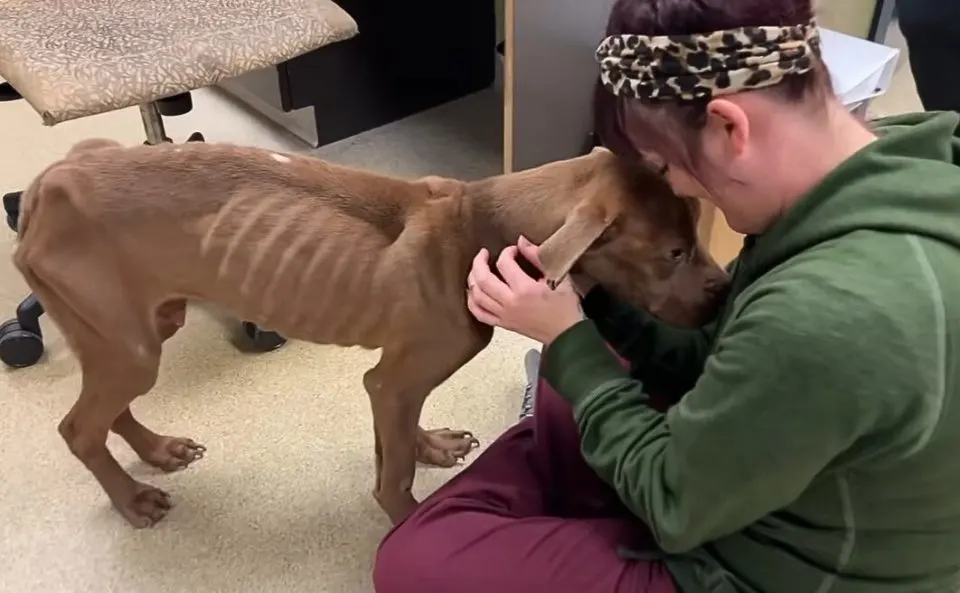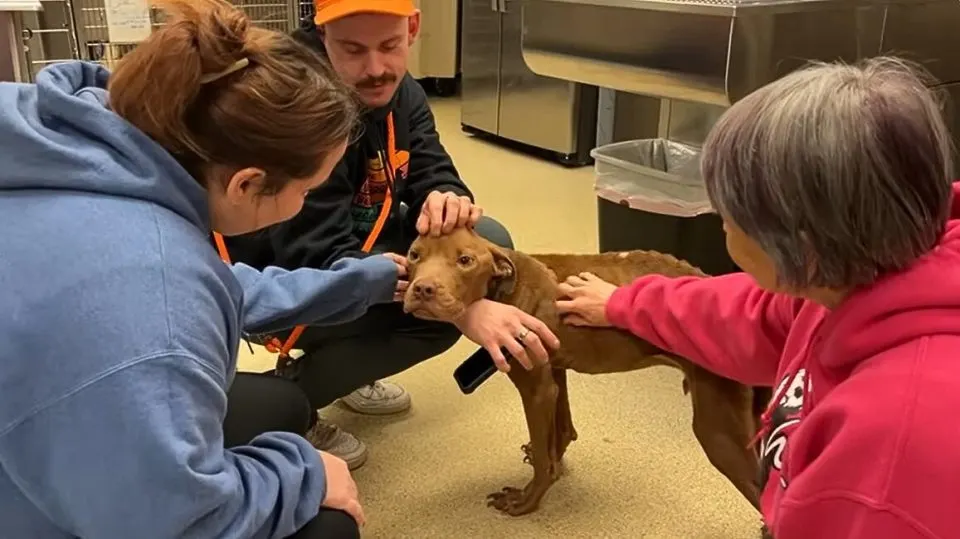Stray canines live in hope that someone will finally smile at them, lend them a helping hand, and take them to a safe place.
It saddens me to know that many people ignore these homeless pups as if they were invisible and unworthy of help and love.
Despite the long time they spend waiting, these stray canines never lose hope of being rescued.
They keep waiting for good humans who will show them the kindness and compassion that they were deprived of for so long.
Nico is one of the stray dogs who knows how it feels to spend his days out in the cold, hoping to get the help he needs very much. Hungry and alone, he was looking in the distance with a sad expression on his beautiful face.
A Good Human The Pup Was Waiting For

Fortunately, Donna Lochmann, an experienced rescuer at Stray Rescue of St. Louis, a shelter in Missouri, came to his rescue.
She felt heartbroken the moment she saw the pup sitting outside a family home with his sorrowful eyes fixed on the road. He was so skinny that all his ribs were showing.
The doggo’s face lit up as soon as Lochmann greeted him.
He instantly started wagging his little tail and walking towards her with his head bent. It seemed as if he knew right away that she was there to help him.
Lochmann noticed that his back paw was injured.
She cuddled the adorable dog and he melted in her arms. As she stroked him, he laid his head on her leg, feeling relieved that someone showed him some kindness and love. He waited for this moment for so long.

The pooch looked at Lochmann with his beautiful, soulful eyes filled with gratitude. She knew that she didn’t need to put a leash over his neck.
The pup, later named Nico New Beginnings, couldn’t wait to go with her and leave his sad street life behind.
Lochmann carried him to her Jeep. The sweet canine was very excited and his tail never stopped wagging.
She snuggled with him as he laid in the passenger’s seat. Nico felt safe at last and he was soaking up his rescuer’s love. He was ready for his freedom ride.
Nico Gets The Love He Lacked All Along

As soon as Nico arrived at the shelter in St. Louis, he stole the hearts of all the shelter staff.
“He’s made all of us melt with those eyes that look into your soul,” the staff wrote on Facebook.
His shelter friends gave him a lot of love and cuddles. Nico was glad to be surrounded with loving humans. The lovely pooch felt comfortable and he knew that they would help him get better.

As soon as Nico is medically cleared, he will be ready to go to a foster home.
We look forward to seeing him gain weight and turn into a happy dog that enjoys life to the fullest. We have no doubt that Nico will soon steal the heart of his forever family who will love him infinitely.
The delightful Missouri boi deserves all the happiness in the world.
If you’ve ever wonderred why your furry friend can’t indulge in that delicious ham you’re enjoying, there’s a good reason behind it. As a seasoned dog trainer, I’ve come across this question countless times. Dogs, with their wagging tails and puppy eyes, might seem like they can eat anything, but when it comes to ham, it’s a different story.
You might be tempted to share your meal with your loyal companion, but there are important factors to consider when it comes to feeding dogs human food like ham. Understanding the reasons behind why dogs can’t have ham is crucial for their health and well-being. Let’s take a closer look at why this popular meat isn’t the best choice for your four-legged friend.
Understanding a Dog’s Diet
Can Dogs Eat Meat?
Dogs are carnivores at heart. They have a natural inclination towards meat. It forms a significant part of their diet, providing essential nutrients like protein and fats. While dogs can eat most types of meat, including chicken, beef, and fish, it’s important to ensure it’s cooked thoroughly to avoid any potential health risks. However, not all meat is suitable for dogs. Pork products, like ham, are generally not recommended for dogs due to their high salt and fat content, which can lead to digestive issues and other health problems. So, while your dog can enjoy meat as part of their diet, it’s best to stick to dog-friendly options like lean cuts of cooked meat.
The Basics of Dog Nutrition
Understanding your dog’s nutritional needs is crucial for their overall health and well-being. Dogs require a balanced diet that includes proteins, fats, carbohydrates, vitamins, and minerals. Protein, derived from sources like meat, is essential for muscle growth and repair. Fats provide energy and support cell function. Carbohydrates, found in grains and vegetables, offer a source of energy. Additionally, vitamins and minerals play a vital role in various bodily functions, from promoting a healthy coat to supporting immune function. When planning your dog’s diet, it’s essential to consult with your veterinarian to ensure they are receiving the necessary nutrients in the right proportions. This ensures that your furry companion stays healthy and happy for years to come.
The Risks of Feeding Ham to Dogs
High Salt Content and Its Effects
Too much salt in ham can lead to salt poisoning in dogs. Excessive salt intake can cause dehydration, vomiting, diarrhea, and in severe cases, sodium ion poisoning. It’s essential to avoid feeding ham to your furry friend to prevent these harmful effects.
Pancreatitis and Fatty Foods
Dogs are susceptible to pancreatitis, an inflammation of the pancreas, from consuming fatty foods like ham. The high fat content in ham can trigger this condition, leading to symptoms such as abdominal pain, vomiting, and loss of appetite. Keep your dog safe by steering clear of fatty meats like ham.
Preservatives and Nitrates in Processed Ham
Processed ham contains preservatives and nitrates that are harmful to dogs. These additives can cause digestive issues, allergic reactions, and may even contribute to the development of certain cancers in dogs. Opt for safer protein sources like plain, cooked meats to minimize health risks for your pet.
Healthy Alternatives to Ham for Dogs
Safe Meat Options
When looking for safe meat options for your furry friend, consider lean proteins like cooked chicken or turkey. These meats are lower in fat and salt compared to ham, making them healthier choices for your dog’s diet. Additionally, lean beef can also be a good alternative to ham, providing your dog with essential nutrients without the risks associated with processed pork products.
Vegetables and Fruits Dogs Can Enjoy
Incorporating vegetables and fruits into your dog’s diet can offer a variety of nutrients and flavors. Carrots, green beans, and sweet potatoes are excellent vegetable options that are safe for dogs to eat. These vegetables provide essential vitamins and fiber without the high fat and salt content found in ham. As for fruits, small amounts of blueberries, apples, and bananas can be healthy treats for your canine companion, adding some sweetness to their diet without the risks posed by ham. Remember to always introduce new foods gradually to ensure your dog’s digestive system adjusts smoothly.
How to Respond If Your Dog Eats Ham
Monitoring for Symptoms of Illness
If your dog has consumed ham, keep an eye out for potential symptoms of illness. Watch for signs such as vomiting, diarrhea, lethargy, excessive thirst, or bloating. These could indicate salt poisoning or pancreatitis, both of which can be serious health concerns for your pet.
When to Contact the Vet
If you notice any concerning symptoms or behaviors in your dog after eating ham, it’s essential to contact your veterinarian promptly. Seek professional guidance if your dog shows persistent vomiting, diarrhea, abdominal discomfort, or any other unusual signs. Early intervention can help prevent complications and ensure your dog receives appropriate treatment for any potential health issues.
Conclusion
So, there you have it – ham might be a tasty treat for you, but it’s a big no-no for your furry friend. Remember, those salty and fatty slices can spell trouble for your dog’s health, leading to serious issues like salt poisoning and pancreatitis. Stick to safer options like cooked chicken or lean beef to keep your pup happy and healthy. Watch out for any signs of distress if your dog sneaks a bite of ham, such as vomiting, diarrhea, or unusual lethargy. When in doubt, reach out to your vet for guidance on a balanced diet that suits your dog’s specific needs. Your pup’s well-being is worth the extra care!
Frequently Asked Questions
Can dogs eat ham?
Feeding ham to dogs is not recommended due to its high salt and fat content, which can lead to salt poisoning and pancreatitis.
What are the risks of giving ham to dogs?
High salt and fat content in ham can cause salt poisoning and pancreatitis in dogs, leading to serious health issues.
What are healthier alternatives to ham for dogs?
Opt for safer protein sources like cooked chicken or lean beef as healthier alternatives to ham for dogs.
What symptoms should I watch for if my dog eats ham?
Monitor your dog for symptoms like vomiting, diarrhea, lethargy, excessive thirst, or bloating after eating ham, as they could indicate serious health issues.
When should I contact a vet if my dog eats ham?
Contact a veterinarian promptly if your dog shows concerning symptoms after eating ham to prevent complications and ensure appropriate treatment.
Why is consulting a vet important for a dog’s diet?
Consulting with a vet for a balanced diet tailored to your dog’s needs is crucial for their overall health and well-being.
[no_toc]

Hey there, I’m Janet Brooks, a dog-loving student from California. I’m all about helping pups in need, especially those without homes. Me and my awesome friends work together to give shelter and love to stray dogs. Oh, and I also write blogs about dogs to share helpful info.